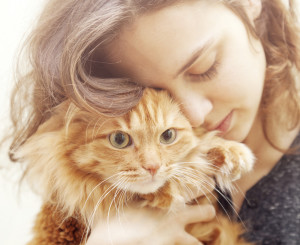In 64 million American household’s pets are a source of joy and perhaps even the key to longer, healthier lives. However, pet-owning households with young children, pregnant women, and people with weakened immune systems need to be aware that their animals can play host to disease-causing microorganisms.
Humans are not likely to catch a disease through their pets, but in very rare cases it can happen. Fortunately, most of these diseases rarely occur in healthy individuals, are mild and can be easily treated. Others, like toxoplasmosis, can be far more serious. Diseases transmitted from animals to humans are called zoonotic diseases. Zoonotic diseases usually live out their complex life cycles in animals, but sometimes cross into human bodies. Usually contracting a pet-borne disease requires very close contact with animals or their excretions, so zoonotic diseases can be avoided with common sense, cleanliness and regular pet examinations and vaccinations.
Children often put their hands in their mouths, providing an easy route for bacteria to travel into their bodies. For example, children who eat dirt are more susceptible to contracting zoonotic diseases. Children also are more susceptible to pet-borne illness because they carry fewer antibodies than adults do. The same holds true for puppies and kittens, making them more likely to carry disease than older dogs and cats.
Although the chances of getting a zoonotic disease from your pet are slim, these are some common pet-borne illnesses that can make people sick:
Salmonellosis
This bacteria generally makes its way into human bodies through contaminated food. The bacteria can be passed through animal feces and may cause symptoms like fever, vomiting, diarrhea and exhaustion.
Roundworms
Roundworm eggs and microscopic adult worms can be excreted in the feces of dogs and cats infected by the worms. Children may be at a higher risk for contracting roundworms because they play near pets or touch infected feces and put their hands into their mouths. Because of the risk to children, all cats and dogs should be taken to their veterinarians for regular fecal examinations. Also remember to cover all sandboxes when not in use to prevent children from contacting contaminated feces. Symptoms can include fever, cough, loss of appetite, weakness and lung congestion.
Cat Scratch Fever
This bacteria is usually transmitted from cats to humans through scratches. The bacteria is found on nails or claws and can cause high fever, loss of appetite, weakness and swollen lymph nodes. In otherwise healthy people, Cat Scratch Fever is usually mild and resolves itself. However, the bacteria caused by Cat Scratch Fever can be extremely dangerous or even fatal if left untreated in immune-compromised individuals. It’s important for these pet owners to tell their doctors they own a cat. Young children should be sure to wash scratches thoroughly with soap and water.
Strep Throat
Though your pet is probably not the culprit bringing strep into your household each year, the possibility does exist. Recently, researchers have found that it’s more likely that people are infecting their pets. In any case, keep your children from kissing, licking or exchanging food by mouth with their pets.
Ringworm
A fungal infection of the skin, hair or nails, ringworm starts as a rapidly spreading hairless, circular lesion. Humans can be infected through use of contaminated objects like hair brushes, towels or clothing or by contact with infected animals like cats, dogs, mice, rats and guinea pigs.
Scabies
Also called sarcoptic mange, scabies is a skin disease caused by itch mites which burrow under the skin. Scabies cause intense itching and scratching that can result in severe eczema. Humans can be infected through contact with infected animals.
The most effective way to prevent zoonotic diseases and ensure your good health is to ensure good health for your pets. This means taking your pet to the veterinarian for regular exams and vaccinations. Most pet owners find that by following their veterinarian’s nutritional and health recommendations, their pets will lead happy, healthy lives with little risk of zoonotic infections.



